
RSC Advances
Subject area
Nanomaterials articles published in the last
6 months

Fabrication and characterization of a novel magnetic nanostructure based on pectin–cellulose hydrogel for in vitro hyperthermia during cancer therapy
The graphical abstract of the design and synthesis of a new magnetic nanobiocomposite based on cross-linked pectin–cellulose hydrogel substrate for in vitro hyperthermia of cancer therapy.

RSC Adv., 2024,14, 13676-13684
https://doi.org/10.1039/D3RA08067F
Photostabilities and anti-tumor effects of curcumin and curcumin-loaded polydopamine nanoparticles
In this study, the PDA-Cur NPs has been successfully synthesized and proved to be an anticancer agent with better photostability and increased utilization of curcumin in PDT.

RSC Adv., 2024,14, 13694-13702
https://doi.org/10.1039/D4RA01246A
Ultra-high Q-factor and amplitude-tunable Fano resonance in vanadium dioxide–silicon hybrid metamaterials
We present a VO2-silicon metamaterial with Q factor up to 165 198 that can be used for terahertz sensing. By adjusting the conductivity of VO2, an optical switching function with a modulation depth of 98.9% can be realized.

RSC Adv., 2024,14, 13646-13653
https://doi.org/10.1039/D4RA01301H
Nanoparticles incorporated hydrogels for delivery of antimicrobial agents: developments and trends
Nanoparticle-hydrogel systems are versatile biomaterials that possess numerous advantages for biomedical applications. This review focuses on the application of the nanoparticle-hydrogels system for the delivery of antimicrobial agents.
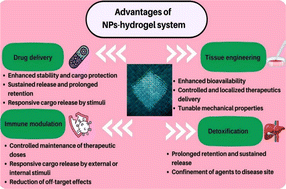
RSC Adv., 2024,14, 13535-13564
https://doi.org/10.1039/D4RA00631C
Recent advances in the functionalization, substitutional doping and applications of graphene/graphene composite nanomaterials
Recently, graphene and graphene-based nanomaterials have emerged as advanced carbon functional materials with specialized unique electronic, optical, mechanical, and chemical properties.

RSC Adv., 2024,14, 13413-13444
https://doi.org/10.1039/D3RA07072G
NiOx/PANI nanocomposite doped carbon paste as electrode for long-term stable and highly efficient perovskite solar cells
Carbon-based perovskite solar cells (PSCs) have emerged as a hopeful alternative in the realm of photovoltaics.

RSC Adv., 2024,14, 13374-13383
https://doi.org/10.1039/D4RA01287A
Effects of external light in the magnetic field-modulated photocatalytic reactions in a microfluidic chip reactor
Mutual enhancement of plasmonic photocatalytic reaction by both magnetic field and plasmonic enhancement was presented through Au–TiO2 nanoparticles.
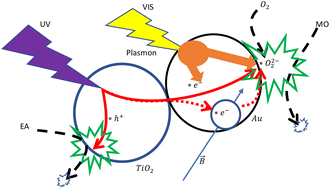
RSC Adv., 2024,14, 13053-13061
https://doi.org/10.1039/D4RA00415A
High performance electrochemical CO2 reduction over Pd decorated cobalt containing nitrogen doped carbon
Efficient electrocatalytic CO2 reduction reaction (eCO2RR) to various products, such as carbon monoxide (CO), is crucial for mitigating greenhouse gas emissions and enabling renewable energy storage.
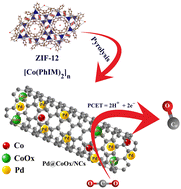
RSC Adv., 2024,14, 13017-13026
https://doi.org/10.1039/D4RA01641F
Superhydrophobic foam combined with biomass-derived TENG based on upcycled coconut husk for efficient oil–water separation
Ocean ecological environments are seriously affected by oil spilling and plastic-debris, significantly reducing marine pollution via using biocomposite production from natural fiber reinforcement is a friendly way to deal with marine oil pollution.

RSC Adv., 2024,14, 13005-13015
https://doi.org/10.1039/D4RA01841A
Smart materials for flexible electronics and devices: hydrogel
In recent years, flexible conductive materials have attracted considerable attention for their potential use in flexible energy storage devices, touch panels, sensors, memristors, and other applications.
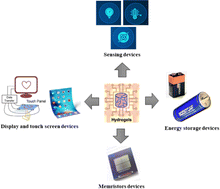
RSC Adv., 2024,14, 12984-13004
https://doi.org/10.1039/D4RA01168F
Highly homogeneous and stable single-walled carbon nanotubes dispersion modified by polyvinylpyrrolidone and alkanolamine in water
An easy green non-covalent surface functionalization of pristine SWCNT was carried out by using ball grinding technology, resulting in the formation of a highly homogeneous and stable PA-SWCNTs dispersion reported firstly in water.

RSC Adv., 2024,14, 12947-12953
https://doi.org/10.1039/D4RA01614A
Cellulose/silica composite microtubular superfoam with excellent flame retardancy, thermal insulation and ablative resistance
Cellulose/SiO2-based composite microtube superfoam exhibits excellent flame retardant, thermal insulation and ablative resistance.
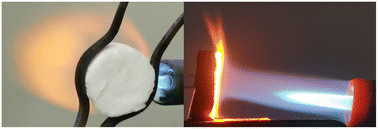
RSC Adv., 2024,14, 12911-12922
https://doi.org/10.1039/D4RA00426D
Enhanced photocatalytic performance of ZnO under visible light by co-doping of Ta and C using hydrothermal method
C, Ta-co-doped ZnO nanoparticles (Eg = 2.88 eV), prepared by hydrothermal method, were used as a photocatalyst under visible light to remove organic contaminants in aquatic environments.

RSC Adv., 2024,14, 12954-12965
https://doi.org/10.1039/D4RA00579A
Novel supramolecular luminescent metallogels containing Tb(III) and Eu(III) ions with benzene-1,3,5-tricarboxylic acid gelator: advancing semiconductor applications in microelectronic devices
Supramolecular metallogels with Tb(III)- and Eu(III)-ions, formed using benzene-1,3,5-tricarboxylic acid, display remarkable stability at room temperature. They hold promise for use in electronics, notably as reliable ambient Schottky barrier diodes.

RSC Adv., 2024,14, 12829-12840
https://doi.org/10.1039/D3RA07903A
Engineering gold nanoworms with tunable longitudinal plasmon peak in the near infrared and their refractive index sensing properties
Gold nanoworms (NWs), synthesized in a one-step reaction with size controlled by pH, show tunable plasmon peaks in the near-infrared. Finite element analysis validates their optical properties, and they exhibit sensitive refractive index sensing.

RSC Adv., 2024,14, 12772-12780
https://doi.org/10.1039/D4RA00994K
Construction of glutathione-responsive paclitaxel prodrug nanoparticles for image-guided targeted delivery and breast cancer therapy
HA-coated redox sensitive visualized nano-prodrug HA/TPE-CS-SS-PTX were exploited in order to highly efficient treatment of cancer and real-time monitoring of drug localization.
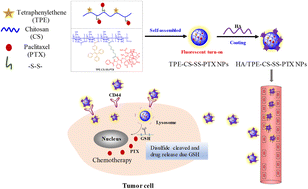
RSC Adv., 2024,14, 12796-12806
https://doi.org/10.1039/D4RA00610K
Fabrication of MoS2/rGO hybrids as electrocatalyst for water splitting applications
Environmental degradation and energy constraint are important risks to long-term sustainability in the modern world.

RSC Adv., 2024,14, 12742-12753
https://doi.org/10.1039/D4RA00697F
Innovative surfactant-free synthesis of core–shell SiO2/ZnO particles: rapid ultrasonication and photocatalytic inhibition
This study demonstrates the preparation of SiO2/ZnO core–shell nanoparticles with controllable shell size and their optical properties.

RSC Adv., 2024,14, 12665-12675
https://doi.org/10.1039/D4RA01309C
Insights into the optoelectronic behaviour of heteroatom doped diamond-shaped graphene quantum dots
Investigation of heteroatom (N, B, O, P and S) doping impact on the structural, optoelectronic and photoluminescence properties of diamond-shaped graphene quantum dots for photovoltaics and nanomedical applications, and energy technologies.
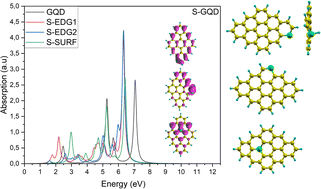
RSC Adv., 2024,14, 12639-12649
https://doi.org/10.1039/D4RA00603H
Significantly enhanced catalytic performance of Pd nanocatalyst on AlOOH featuring abundant solid surface frustrated Lewis pair for improved hydrogen activation
The superior catalytic performance of Pd nanocatalysts in AlOOH-80 is attributed to solid surface frustrated Lewis pairs (ssFLP), which enhance hydrogen gas dissociation, improve Pd nanocatalyst hydrogenation, and result in high catalytic activity of Pd/AlOOH-80.

RSC Adv., 2024,14, 12593-12599
https://doi.org/10.1039/D4RA01852D
Synergistic effects of β-NaFeO2 ferrite nanoparticles for photocatalytic degradation, antibacterial, and antioxidant applications
Detailed antibacterial mechanism using by synthesized β-NaFeO2.

RSC Adv., 2024,14, 12513-12527
https://doi.org/10.1039/D4RA02430C
Tunable thermal diffusivity of silk protein assemblies based on their structural control and photo-induced chemical cross-linking
The tunable thermal diffusivity of silk fibroin-based assemblies (films) is demonstrated here. The control of secondary structures and subsequent photo-induced chemical cross-linking are essential for heat conduction in the films.

RSC Adv., 2024,14, 12449-12453
https://doi.org/10.1039/D3RA06473E
Dual-functional nano-photosensitizers: Eosin-Y decorated gold nanorods for plasmon-enhanced fluorescence and singlet oxygen generation
Enhancement factors of 110 and 18 for metal-enhanced fluorescence and metal-enhanced SOG, respectively, are obtained from polymer coated gold nanorod cores adsorbed with Eosin Y.
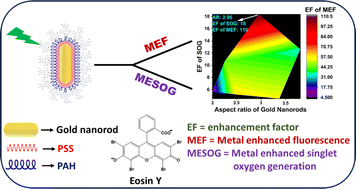
RSC Adv., 2024,14, 12417-12427
https://doi.org/10.1039/D4RA01551G
Enhanced acetone gas-sensing characteristics of Pd–NiO nanorods/SnO2 nanowires sensors
The ternary component consisting of SnO2 nanowires/Pd–NiO nanorods is employed to enhance the acetone gas sensor performance utilizing the synergistic effects of the p–n heterojunction between the p-type NiO and the n-type SnO2, as well as the catalytic spillover effect of Pd nanoparticles.

RSC Adv., 2024,14, 12438-12448
https://doi.org/10.1039/D4RA01265H
A self-powered photodetector through facile processing using polyethyleneimine/carbon quantum dots for highly sensitive UVC detection
Ultraviolet C (UVC) photodetectors have garnered considerable attention because the detection of UVC is critical for preventing skin damage in humans, monitoring environmental conditions, and detecting power aging in military applications.
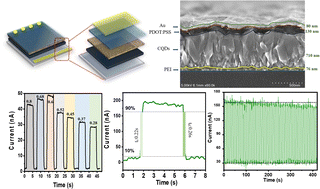
RSC Adv., 2024,14, 12360-12371
https://doi.org/10.1039/D3RA08538D
Browse by Subject
- All (340 articles)
- Atomic/elemental (15 articles)
- Bioanalytical (70 articles)
- Chemometrics (30 articles)
- Crystallography (171 articles)
- Electroanalytical (58 articles)
- Imaging/microscopy (34 articles)
- Mass spectrometry (24 articles)
- Medical diagnostics (80 articles)
- Microfluidics (16 articles)
- Nanoanalysis (20 articles)
- Separation science (27 articles)
- Spectroscopy (95 articles)
- All (273 articles)
- Bioinorganic chemistry (52 articles)
- Bioorganic chemistry (28 articles)
- Biotechnology (46 articles)
- Cellular chemistry (60 articles)
- Computational (86 articles)
- Drug delivery (73 articles)
- Drug discovery (185 articles)
- Imaging/diagnostics (14 articles)
- Molecular biology (7 articles)
- Nanotechnology (39 articles)
- Natural products (29 articles)
- Pharmacology (92 articles)
- Photobiology (15 articles)
- Polymorphism (pharma) (1 article)
- Structural biology (12 articles)
- Toxicology (3 articles)
- All (554 articles)
- Biomaterials (102 articles)
- Biopolymers (98 articles)
- Carbon materials (102 articles)
- Composites (244 articles)
- Electronic materials (91 articles)
- Encapsulation (1 article)
- Energy applications (82 articles)
- Films/membranes (82 articles)
- Gels & soft matter (34 articles)
- Inorganic materials (48 articles)
- Medical materials (66 articles)
- Nanomaterials (124 articles)
- Optical materials (49 articles)
- Organic materials (50 articles)
- Polymers (126 articles)
- All (342 articles)
- Assembly (10 articles)
- Biotechnology (29 articles)
- Carbon nanomaterials (80 articles)
- Imaging/microscopy (15 articles)
- Nanoanalysis (39 articles)
- Nanocatalysis (34 articles)
- Nanomaterials (215 articles)
- Nanomedicine (40 articles)
- Nanotoxicology (51 articles)
- Optical nanomaterials (33 articles)
- Synthesis (13 articles)
- All (183 articles)
- Bioorganic (18 articles)
- Catalysis (46 articles)
- Fine chemicals (27 articles)
- Natural products (25 articles)
- Physical organic (9 articles)
- Stereochemistry (11 articles)
- Supramolecular (3 articles)
- Sustainable synthesis (36 articles)
- Synthetic methodology (107 articles)
- Total synthesis (13 articles)
- All (329 articles)
- Biophysics (2 articles)
- Charge transfer (30 articles)
- Electrochemistry (12 articles)
- Energy research (18 articles)
- Imaging/microscopy (6 articles)
- Kinetics & dynamics (42 articles)
- Materials (107 articles)
- Mechanics (33 articles)
- Nanoscience (73 articles)
- Photoscience (27 articles)
- Quantum & theoretical (92 articles)
- Simulations (22 articles)
- Single molecules (45 articles)
- Soft matter (5 articles)
- Spectroscopy (7 articles)
- Surfaces & interfaces (71 articles)